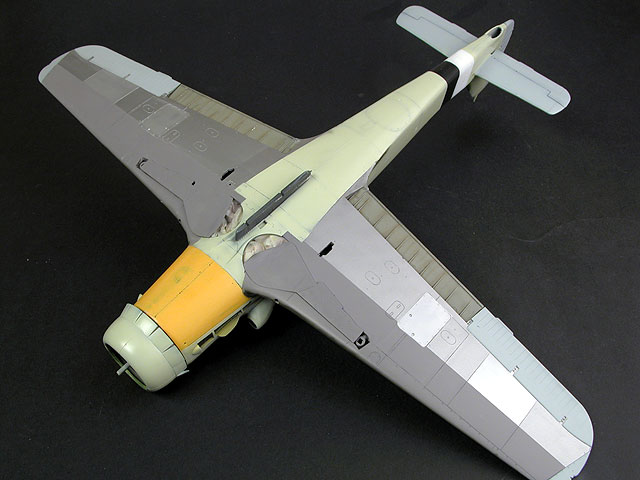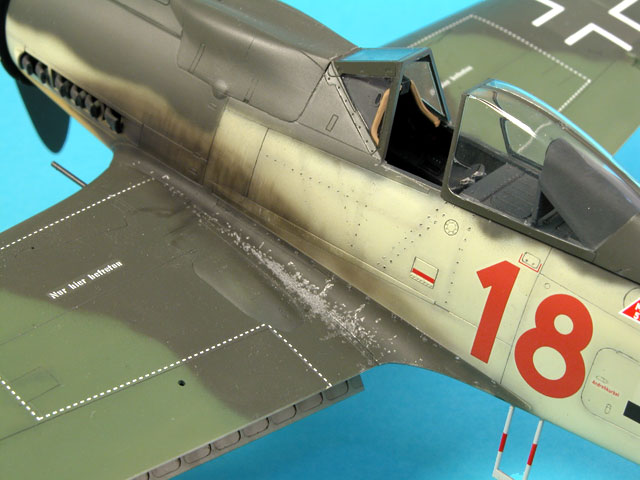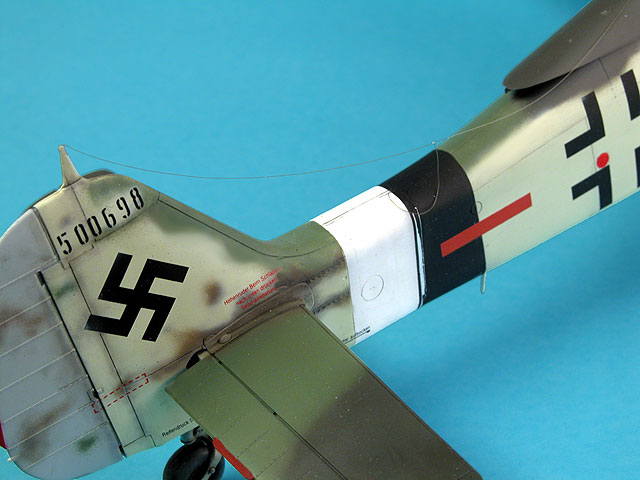|
Preparation
I decided to follow one of Dave Aungst's tips and mask the
canopy with Parafilm "M". For details of how to use this interesting
masking material, see
Dave's
article in the Reference Library.

Wheel wells were stuffed with tissue then the
undercarriage doors were tacked in place with Blue-Tack.
I cut out a circle from a Post-It Note to mask off the big
annular radiator, which had already been painted and received a wash of
black oil paint.
This Fw 190D was from the 500XXX werknummer batch.
Aircraft from this batch shared some interesting colour attributes,
including the lower wing with a grey forward half and natural metal
trailing half. The fuselage of these aircraft also seem to be finished in
one of the late-war “Sky” shades. Just to add even more variety, the lower
engine cowl of "Brown 18" is a different shade to the rest of the
fuselage, suggesting that it might be yellow or natural metal; and JG 26
added their own unique colours to the mix with a Black and White RV band
and “greened-up” top surface camouflage.
Painting
The first task was depicting bare metal on the lower wing.
I like Tamiya's AS-12 Bare-Metal Silver from the spray
can, but the aerosol application sometimes leaves a slight orange-peel
texture. I therefore took a small container, covered it with Cling Wrap,
poked a small hole in the corner and sprayed some of the contents of the
can into the hole. This is definitely an outdoor job. Keep your
face away from the billowing toxic lacquer vapours too!
The cling wrap was removed and the contents poured into an
empty Testor glass jar. I left the jar open for a few minutes before use
to permit some of the remaining aerosol to evaporate.
Now the silver paint can be used just like normal lacquer.
I poured the thin liquid straight into my Aztek paint cup and covered the
rear part of the lower wing with a slightly dull, perfectly smooth and
metallic finish. This is a great undercoat for Testor Metalizers. In fact,
I mixed Metalizer with the Tamiya lacquer in the paint cup to vary the
shade of selected panels.
Final tip for the decanted spray paint - take care the
first time you re-open the jar as the contents may repressurize slightly.

The metallic rear section was masked and I pre-shaded the
remaining panel lines with narrow lines of black paint applied with the
airbrush. Next, the black and white of the RV band was sprayed and masked,
followed by the yellow undercowl. The remaining colours of the patchwork
underside were then painted - RLM 75 Grey Violet for the forward lower
wing; RLM 76 Light Blue for the ailerons, wing tips and horizontal tail
surfaces; and "sky green" (RLM 76 variation) using RAF Sky.
The one known decent photo of this aircraft (on page 303
of Axel Urbanke's wonderful book, "Green Hearts - First in Combat with
the Dora 9") indicates a fairly high, hard demarcation line on the
fuselage side with almost no mottling. The fin has a line of dark
camouflage on the leading edge, but only sparse mottling aft of this. The
rudder has been removed in the photo so camouflage of this area is
anyone's guess.
Upper surfaces were painted with RLM 82 Dark Green and RLM
83 Bright Green in accordance with JG 26's camouflage practices. I painted
the rudder RLM 76 Light Blue. The mottle comprised RLM 81 Brown Violet
(presumably field applied) and RLM 83 Bright Green.
A few weathering features are apparent in the reference
photo, including chipped paint on the RV band and putty/primer on the gear
doors.
When all the masking was removed I applied a narrow strip
of self-adhesive aluminium foil each side of the fuselage extension join.
This was rubbed down into position then smaller strips were sliced off the
top and the bottom. These strips represent metal under damaged paint -
fairly common in this spot on Doras.
I also brush-painted beige and dull red spots on the main
undercarriage doors representing patches of putty and primer.
Click the thumbnails below
to view larger images:
|
|

|
|
The natural metal rear section of the wing was first painted with Tamiya Airframe Silver from a spray can, decanted into a jar.
|
|

|
|
Testor Metalizer was used to add variety in panel shades.
|
|

|
|
The airframe was pre-shaded with thinly applied flat black.
|
|

|
|
Camouflage colours were applied to permit a hint of the pre-shading to show through.
|
|

|
|
Ready for decals!
|
|
|
Decals and Finishing Touches
With the large expanse of pale paint on the fuselage side,
I decided to subtly highlight the panel lines with a very thin wash
of Lamp Black and Raw Umber oil paint.
Decals for Brown 18 were sourced from EagleCals' brand new
sheet number EC#58. A
detailed review of these decals may be seen elsewhere on HyperScale.
The decals behaved perfectly on application.
Click the thumbnails below
to view larger images:
|
|

|
|
The resin cigar fuel tank from Jerry Rutman. The resin sway-brace mounts were sliced off the front position and relocated to suit the kit parts.
|
|

|
|
The kit fittings only needed a little work to adapt to the Rutman drop tank.
|
|
|

|
|
Panel lines were slightly highlighted before decals were added.
|
|
|
|
After the decals had thoroughly dried, I sprayed a sealing
coat of Polly Scale Flat. There was still some work to be done though.
The reference photo shows a dark exhaust streak on the
forward part of the aircraft. I mixed some Flat Black, Red Brown and a
spot of Flat Base with approximately 80% thinner. This thin mix was first
applied in tiny vertical streaks on the fuselage sides, then along panel
lines that were destined to lie under the stain, and finally built up
gradually for the entire length of the dirty streak.
Scuffing and chipping of paint along the wing roots was
achieved with a silver artist's pencil. It is important to keep the pencil
sharp for the whole job. I re-sharpened the pencil several times before I
was finished.

The characteristic toe-in and forward angle of Fw 190
undercarriage legs has been a problem for model companies until now.
On my kit, the undercarriage legs were such a tight fit
that I could not dry fit them in the locating holes without risking
damage. Fortunately, a thin application of glue was enough to lubricate
the plastic and they almost clicked into place for a magnificent fit and
perfect alignment.
By the way, I accidentally sliced off the locating pins
for the retraction struts on both main undercarriage legs when removing
them from the sprues. This is an easy mistake to make, but also an easy
one to fix. I drilled a shallow hole in the appropriate position on each
leg and superglued a short pin of brass rod as a replacement.
Small detail parts such as the striped Morane mast and
footstep were painted and glued to the model.

Focke-Wulf 190 aircraft equipped with the standard (flat)
hood had a pulley system inside the canopy that kept the antenna wire taut
whether the sliding section was open or closed. The blown hood did not
have this mechanism. The wire simply hooked onto the top of the canopy and
slackened off when the hood was open.
I usually use invisible mending thread for antenna wire,
but I have not had much luck getting this material to look convincingly
slack. I therefore stretched a length of dark green sprue using a candle.
The stretched sprue can be positioned to a certain extent. A long section
of stretched sprue was strung between the fin antenna post and the top of
the canopy. A short piece was curled at one end to depict the slack
lead-in wire on top of the fuselage entry point.
The Dora was finished, and in fairly quick time. I
estimate that construction took around 12 hours, with painting and
detailing another 15 hours or so.
Since its release in late 2001, I have seen far more
photos and articles of Hasegawa 1/32 scale Bf 109G-6 submitted to
HyperScale than any other single model – and with good reason. That kit is
quite accurate, pleasant and fast to build, offers a staggering range of
finishing options, is an impressive size without making big demands on
display space, is not burdened with esoteric gimmicks and the price is
affordable.
Hasegawa’s new 1/32 scale Focke-Wulf 190D-9 continues this
sensible philosophy with all the same qualities as the earlier Gustav.
The Dora is slightly more demanding than the Bf 109 with respect to the
wing/fuselage join, but it is still well within the scope of most
modellers.

I think that Hasegawa’s 1/32 scale Focke-Wulf Fw 190D-9 is a terrific kit
that deserves great sales success. It will look good built straight from
the box, but also represents an excellent platform for superdetailers to
weave their magic.
Tamiya, Revell and Trumpeter are doing a good job with large scale jets.
We can only hope that Hasegawa continues to cover more 1/32 scale WWII
subjects. Who wants to see a state-of-the art Mustang, Fw 190A/F/G, a late
mark Spitfire or a Hurricane in this scale?
Who wouldn’t!
This project was a much more enjoyable experience thanks
to the assistance of:
-
Jerry Crandall from
Eagle Editions for the
commentary on his construction; assistance with reference questions on the
subject aircraft and the provision of decals.
-
Jerry Rutman of
J. Rutman Productions for the
provision of the resin "cigar" fuel tank last year in the "Focke-Wulf
Fw 190D-9 Late Style Conversion" (for the old Hasegawa Dora)
-
Meteor Productions for the review
sample Fw 190A-8 cockpit way back in 2000 - I knew that I would use
it eventually!
Click the
thumbnails below to view larger images:
Model, Images and Text
Copyright © 2003 by
Brett Green
Page Created 26 April, 2003
Last Updated
17 March, 2004
Back to
HyperScale Main Page |
Home |
What's New |
Features |
Gallery |
Reviews |
Reference |
Forum |
Search